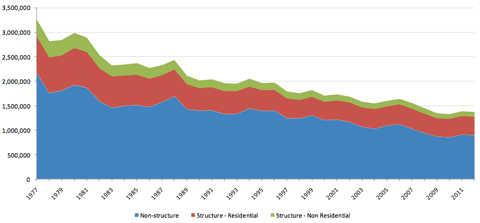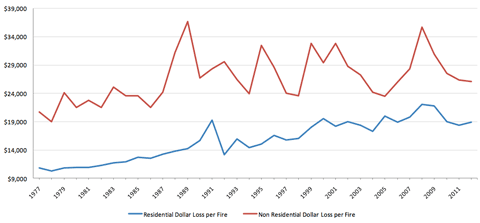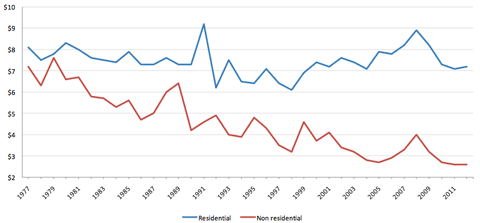What Are The External Benefits Of Firefighting Services
An Analysis of Fire Service Trends and Impacts
By Rick Stoll
Other than those who work in the burn down service, people don't usually call up nearly the risks of fire — perhaps except when they run across a fire truck going downwardly the street. Those in the burn down service, even so, are focused and adamant to achieve their mission to reduce fire injury and fatality rates, decrease property damage, and contribute to a customs's reputation as a condom surroundings for homeowners and businesses.
To understand how this mission tin can exist achieved, we must first examine trends affecting the burn down service and their resulting effects. In 1973, the National Committee on Burn Prevention and Command delivered a powerful report to President Nixon that outlined America's fire trouble and future recommendations. In addition to horrific real-world examples, the written report asserted, "Appallingly, the richest and most technologically avant-garde nation in the world leads all the major industrialized countries in per capita deaths and property loss from fire." 1 As a direct result of the study, significant resources were spent on public awareness, prevention, fire service training, building code improvements, and inquiry. Those efforts and other irresolute dynamics resulted in iv major trends that accept affected the burn service.
one. Significant Subtract in Fire Frequency
A major consequential trend is a significant decrease in burn down frequency. Fire incidents have dropped by 57 percent since 1977, co-ordinate to the National Fire Protection Clan (NFPA). This statistic is even more pronounced when you lot consider a respective 41 percent increase in population. The subtract is primarily driven by nonstructure fires and residential structure fires, with a significant reduction in heating-related fires.
Fire Incident History

Data source: NFPA
The biggest contributing factors were prevention activities and technology improvements, including public education, smoke alarm adoption, updated heating equipment, and the adoption and enforcement of stronger building codes. A review of detailed data and characteristics of the leading factors indicates that with the national focus on fire prevention having lasted a full generation, its positive impact has largely been realized. Therefore, without additional intervention, the decrease in fire frequency is not expected to continue.
2. Drastic Increase in Rate of Burn Burn
Changes in both residential and commercial building contents, every bit well as in structure materials and methods, have had a significant impact on burn temperature and rate of burn down. A recent press release from UL (a global independent prophylactic science company) stated that "shifts in mod dwelling house structure and pattern are contributing to a new reality: Fires tin can get uncontrollable in less than iii minutes and reach flashover eight times faster." 2
This phenomenon is exacerbated by a alter in room contents, such as the transition from cotton-based to foam-based article of furniture. Since the changeover has already occurred in the majority of homes, the increase in fire burn rate is non expected to go along.
New burn down safety regulations to address this hazard are unlikely given the celebrated subtract in fire frequency and the associated public perception that the take a chance of fire is low. Without new regulations, production manufacturers will continue to focus on value and price — with little attention given to fire condom.
3. Greater Risk of Edifice Collapse
Dollar Loss Per Structure Burn (in 2012 Dollars)

Data source: NFPA
Changes in building structure accept increased the risk of collapse. New constructed structure materials and larger homes with high ceilings and open floor plans are the principal reasons. Where older homes used interior structural support columns and walls, open plans utilise truss systems that are much more than likely to fail when elements are compromised.
The prevalence of building collapse volition continue to increment equally building stock trends toward a higher percent of newer homes. Although half of all housing units are still "legacy" (that is, built before 1970), information technology is a dwindling number. Equally it is, firefighters are establishing new criteria for entering buildings that may be structurally unsound. Unless edifice and burn codes are updated to address this trend, the problem will simply worsen.
The combination of faster-burning fires and an increased likelihood of plummet has resulted in an increase in loss per burn for both residential and nonresidential structures, according to NFPA information.
While the increase is particularly notable for residential fires, four primary factors take already helped curtail this increase:
- quicker fire detection due to increased smoke alarm usage
- faster response times facilitated by mod telecommunications centers and the widespread use of jail cell phones
- slower fire growth due to sprinklers and automatic system shutoffs
- a higher percentage of fires originating in the kitchen, where spread is much less likely than fires that starting time in other rooms
Combining the reduction in fire frequency with the increase in loss per fire, total loss is decreasing. This is particularly apparent for nonresidential properties.
Total Fire Loss (in 2012 Billions)

Data source: NFPA
Given the expected future state of the aforementioned iii trends, total fire loss is expected to remain brackish for the foreseeable futurity.
iv. General Improvements in Available Technology
Historically, fire departments take not had the budget or the desire to invest in technology. Notwithstanding, with the rapid acceleration of cost-effective technology, such every bit new media, telecommunications, and data analytics, innovative opportunities are emerging to improve fire section efficiencies. The significance of this acceleration is captured by what'south known as Moore's Police force, which asserts that computing power will double every 2 years. Given the 49-year historical accuracy of this "police force," fire departments will continue to face the opportunities and challenges technological modify presents. While more than data and amend software tools are being adult, departments continue to work under another "law" — the constabulary of dwindling budgets.
Burn down Trend Implications
Fire departments are nonetheless developing their strategies to accost those four burn down trends. With reduced fire frequency, burn down departments are shrinking and have increased their focus on EMS and other hazard-related emergencies. Total calls per firefighter increased from 9.8 per year in 1983 to 29.four per year in 2012. However, fire-related calls per firewoman decreased from two.1 per year to 1.2 per year for the same period. 3 As a result, firefighters have less alive fire experience and less opportunity to hone their firefighting skills. At the aforementioned time, the escalating number of nonfire emergencies requires new training in a broader array of responsibilities.
Due to changing room contents and housing construction materials and layouts, firefighters must respond quicker and are at greater risk of injury from an increased risk of building plummet and exposure to carcinogens.
Hereafter Opportunities
While prevention initiatives tin can still help address the fire service mission, burn down departments volition face up diminishing returns associated with increased activities — and volition demand to quantify the benefits to receive the advisable funding. The prevention endeavour with the greatest continued impact is public educational activity. Future teaching is especially of import to expose the seldom-publicized risks associated with new room contents and edifice construction and to improve the activation of smoke alarms.
Prevention activities that require partnerships beyond the fire service include a focus on sprinkler and cooking engineering science (and adoption) to assistance keep the decline of fire frequency and full dollar loss. While only 5 percent of American homes have sprinklers, they reduce the fire death charge per unit by 82 per centum and belongings harm per fire past 68 per centum. 4 New cooking technology may prevent 75 percent of cooking fires with the use of temperature sensors that tin can prevent cooking materials from igniting.5 This technology is rarely used because of stove incompatibility, cost, and the perception of diminished cooking functioning.
Other prevention opportunities include a greater focus on building codes and upholstered furniture standards. It is important that burn departments work hand in paw with building departments to facilitate adoption and enforcement of building codes that incorporate fire prophylactic measures. A successful partnership tin can help fire departments achieve their mission.
It is important that fire departments piece of work manus in hand with building departments to facilitate adoption and enforcement of building codes that contain fire safety measures.
From an operations and training perspective, fire departments tin can improve efficiencies with municipality partnerships, new technology, and information. Improved communications and ameliorate preplans can improve reaction times to fight faster-burning fires. Fire suppression strategies and training should focus on common burn types and causes, such equally kitchen and vehicle fires. There is also a general need for updated training tools and requirements to business relationship for new technology and reduced alive feel. Finally, analytics and benchmarks can assist provide specific information to improve grant applications, assess performance, quantify the department's benefits to the community, and brand informed decisions related to fire station coverage and local building code improvements.
While burn down loss has decreased, insurance companies would benefit by agreement these trends and implications. Specifically, building codes and community prevention activities are having a greater touch on on the gamble of fire loss. Detection and immediate suppression is as well improved with properly operating sprinklers and activated fume alarms. Identifying methods to quantify the benefits of these increasingly import &nt factors will help more accurately price fire hazard.
- America Burning, The Report of The National Committee on Fire Prevention and Control"; 1973; Howard D. Tipton, Executive Managing director.
- UL Converts Exclusive Fire Research into Online Training to Help Brainwash and Safeguard Fire Service Personnel"; 2012; UL. Note: "Flashover" is the point in time that a room bursts into flames — leaving no survivors.
- National Burn down Protection Association (NFPA)
- U.South. Experience with Sprinklers"; 2013; John R. Hall Jr.; Statistics reference 2009 adoption and benefits associated with moisture-piping sprinklers present in the burn down surface area of homes.
- Technical, Practical and Manufacturing Feasibility of Technologies to Accost Surface Cooking Fires, Final Written report to U.s. Consumer Product Safety Commission" 2001; Arthur D. Footling
Rick Stoll is director of ISO Customs Analytic Services.
What Are The External Benefits Of Firefighting Services,
Source: https://www.verisk.com/verisk-review/archived-articles/an-analysis-of-fire-service-trends-and-impacts/
Posted by: lomeliyousintor.blogspot.com


0 Response to "What Are The External Benefits Of Firefighting Services"
Post a Comment